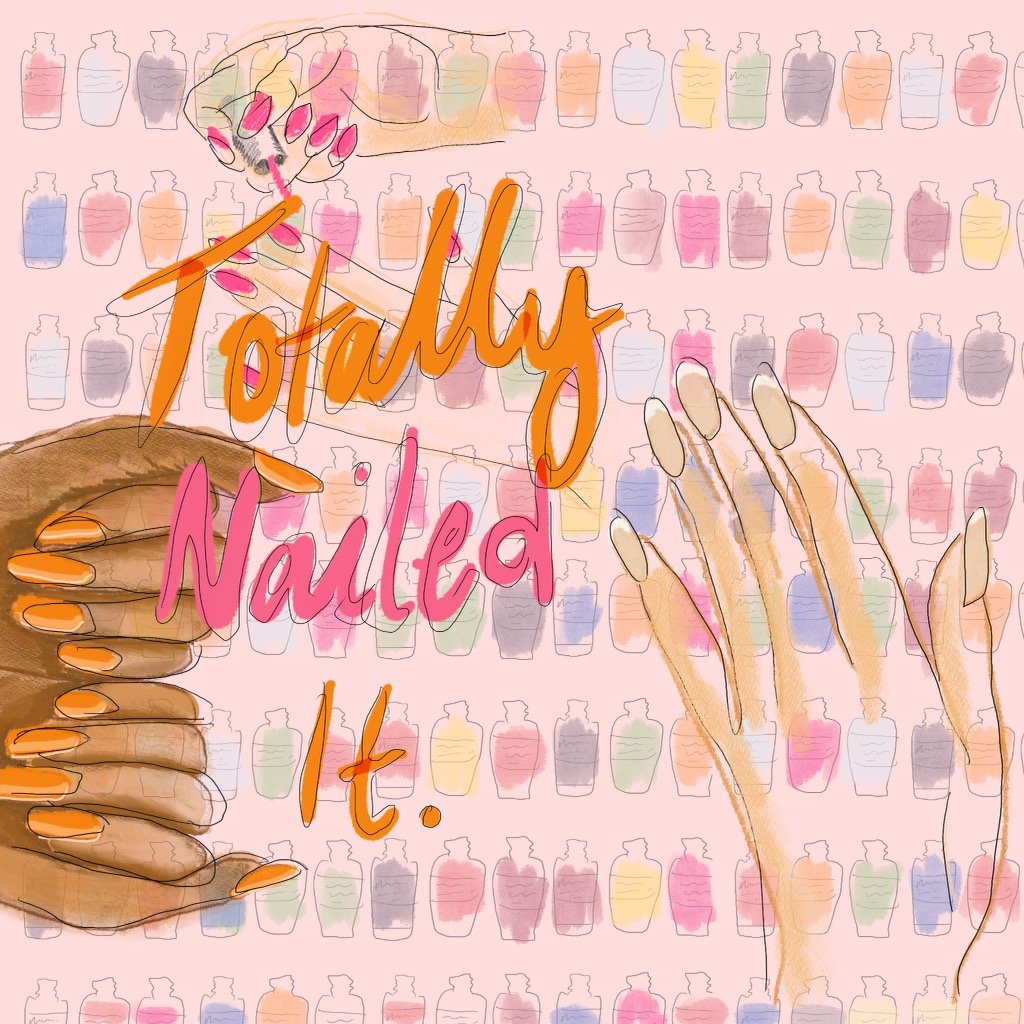Totally Nailed It
Illustration: Agalia Joithe
When I step into a subway car, I always survey my surroundings. Primarily, of course, for safety reasons. But I am also vigilant because of my strong interest in the populace that surrounds me. As I commute on the Metro (what we call the subway in Washington D.C.), I observe people. Who are they wearing? What are they reading? Which hotel did they choose for their next affair? The Hay-Adams? Nice choice, big guy. Rest assured, I’m noticing.
Recently, as I grab a seat, I’ve noticed a phenomenon sweeping across the second most stylish capital city in North America; keep up the good work, Mexico City! Back to my point, there is an abundance of beautifully done nails - like, a lot. But this isn’t unique to Washington. I’ve seen amazing nails washing my hands (full 20 seconds!) in the bathroom at Ale, sitting in Stauffer, or scrolling through TikTok. Women are getting their nails done and those ten small patches of hardened protein, mainly composed of keratin, are the canvases modern Picasso's use to express themselves in rather remarkable ways.
Scholars believe painting nails with “polish” dates back to China over 5,000 years ago. It was the ancient Egyptians who brought “class” to the nail game – literally. Cleopatra and her gang used painted nails to signify social strata, with the lower echelons of society blandly forced to utilize lighter colors, if any paint at all. The upper classes, on the other hand (also literally), regularly found their fingertips colored in a rich red.
Flash-forward a few thousand years, and modern society has discarded the beeswax, egg whites, gelatin or vegetable dyes previously used as nail polish bases. With auto paint as the foundation - a colorless polish was released to the market in the middle of World War I - clean, polished nails became a staple of the “Roaring Twenties.” Do you really think Daisy Buchanan chipped a nail when she ran over that guy with Gatsby’s car? By the early 1930s, Revlon became the first official nail polish brand – and the rest is, as they say, is nail-story.
The influence of nail polish isn’t hardly surprising because hands – specifically, women’s hands – have always had an exaggerated importance in society. Often a means of separating social classes, clean and smooth hands belonged to upper-class women, while gnarled and rough hands were a signal of the working class. But unlike today’s growing gaps between rich and poor, nail art is helping to fuse societal divisions, as many struggle to keep up with nail art trends; they are constantly changing.
As a form of self-expression, nails not only reflect how one sees themselves, but also how they wish to be perceived by the world. The modernization of nail personalization has surely contributed to the recent popularization. There are a plethora of colors, images, and designs available that truly capture one’s personality. After all, having the same nails week after week means they better be unique, interesting and creative. Think about the compliments and attention you receive with a fresh set of nails: those alone make it worthwhile!
Nails can shout to all what your personality is. And perhaps, they even show that you’re up with the trends (many are familiar with the red nail theory; I’ve tried it and the jury is still deliberating on its success). There are so many influences on personal style, each making a person’s nails unique. Whether it be the trends set by Hailey Beiber or abstract designs pioneered by TikToker Ameya Okamoto, having your nails done is the thing to do.
There is also an intersection between nails and culture, which is often unaddressed in modern discussions of fashion trends. In the past, pastel and soft colors were linked with upper-class, typically white women, while eccentric, flashy, lengthy nails were associated with minorities. As a statement of self-expression and cultural pride, women in the Black community have been fashioning their nails for years. Through social media and publications like The Cut, Black nail artists are getting the recognition they deserve – as artists. Recently, as Asia Milia Ware noted in The Cut, Kylie Jenner has been credited with the “long nail trend,” but that is far from true.
The pioneers of long, intricate nails were women in the Black community, who used their nails to express themselves through bright colors, fun designs, and length. Musicians like Diana Ross and Lil’ Kim wore them on album covers and during concert appearances. Back in the 1980s, Olympian sprinter Florence Griffith Joyner set records, but it was her nails that often unfairly stole the show. This unfair standard is something women, particularly women of color, have to contend with: how their undeniable achievements are marginalized by their appearance.
So, next time you get your nails done, take some extra time to ponder the style, shape, color and design you seek. But also, appreciate the development of nail art. Think about who was wearing them long before Hailey Beiber got one coat of Funny Bunny, two coats of Ballet Slippers with just a dash of chrome powder on top. The fingernail is more than a plate, a bed, a cuticle, a fold, a lunula and a matrix. It can be a statement on modern society and where you see yourself in it.

